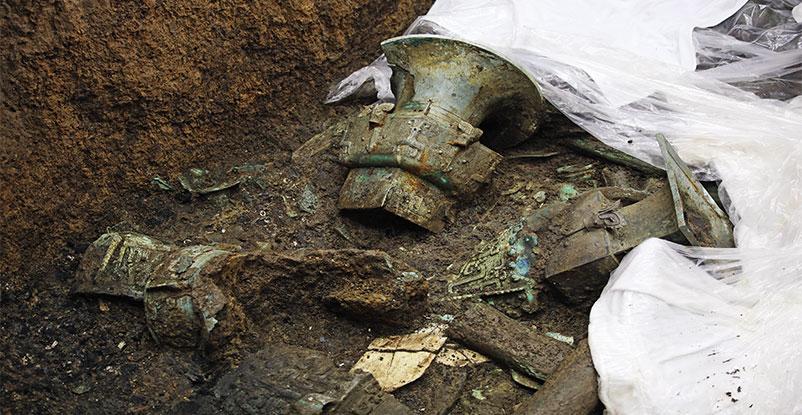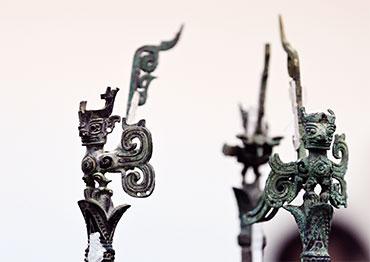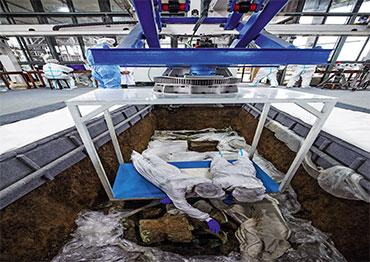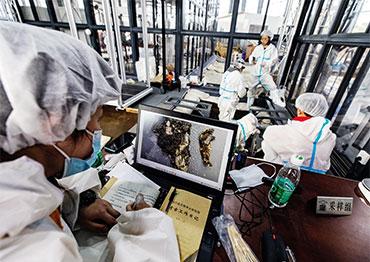The Sanxingdui Ruins site is located on the south bank of the Yazi River in the city of Guanghan, Sichuan Province, some 60 kilometers to the northeast of provincial capital Chengdu.
Interest in the 12-square kilometer area was first piqued in the late 1920s after a farmer dug up jade artifacts. Archaeological excavations formally started in the early 1960s and continued in the 1980s when the first two sacrificial pits were discovered, revealing a stunning collection of over 1,000 relics including bronze figures, bronze trees, gold masks, jade and elephant tusks. But since then, while archaeologists agreed that the discoveries had turned understanding of Bronze Age Chinese civilizations upside down, no major excavation was undertaken at the site for almost four decades.
Only recently did new excavations break the silence.
Chen Xiandan, a researcher at the Sichuan Provincial Cultural Relics and Archaeology Research Institute who participated in a dig in 1986 told NewsChina that in fact, work at Sanxingdui had never stopped. For a long time, the work focused on other functional areas such as delineating features like walls and palaces inside the site rather than the sacrificial pits. “The principle stipulated in China’s Law on the Protection of Cultural Relics states protection is the priority, and salvage excavation [if the artifacts or site are at risk of destruction] comes first, and no active excavation is allowed despite advanced technologies. If an excavation must be conducted, it should be for scientific research purposes and approved by the State Administration of Cultural Heritage,” Chen said.
According to Ran Honglin, team leader of the current dig, artifacts were excavated from four of the newly discovered pits by early April, while another two pits are in the initial excavation stage of clearing the top layers of soil. The dig is led by the Sichuan Provincial Bureau of Cultural Relics and implemented by the Sichuan Archaeology Institute with participation from 34 scientific research institutes and universities from all over the country. “This is perhaps the world’s largest excavation involving people from the domestic archaeological, cultural relics conservation and scientific research field,” said Tang Fei, president of the Sichuan Archaeology Institute. Tang said that the State Administration of Cultural Heritage and the Sichuan Provincial Bureau of Cultural Heritage have earmarked over 32 million yuan (US$4.9m) for the excavation, and an additional 30 million yuan (US$4.6m) for cultural relic protection and multidisciplinary research.
Among the six new pits, No.3 is particularly rich in findings. Within an area of less than 15 square meters, archaeologists have found 109 bronze ware pieces, 127 ivory tusks and eight jade objects. Two square zun, bronze wine vessels used in rituals, decorated with dragon and ox patterns, are unique with nothing similar found in the 1980s exploration. This pit, just as No.2 pit which was unearthed in the 1980s, was covered with a layer of ivory tusks.
The main challenge for archaeologists is to clarify the relationship between the tusks and other artifacts before clean-up work begins. “The tusks were not neatly arranged, but rather were crisscrossed and scattered,” Xu Feihong, a teacher at Shanghai University Fine Arts College and team leader of the No.3 pit excavation, told NewsChina. The pit also revealed a large, U-shaped bronze mask with two ears that shares some complex cultural links with the stacked ivory.
Unlike the salvage excavations at pits Nos. 1 and 2 in 1986, the team was fully prepared for the excavation of the six new pits.
“We must make a reasonable plan and adjust how we proceed with the excavation anytime we feel it’s necessary to ensure that all the objects can be removed properly. Otherwise, the results won’t be acceptable,” Xu added.
There are two main sites where a large number of tusks have been found. Apart from the Sanxingdui Ruins, tusks were found at the Jinsha Ruins in Chengdu, capital of Sichuan Province. This site dates back to 3,200-2,600 BCE, later than Sanxingdui, where experts found a jade carving of a square-eared human figure wearing a crown and robes with a tusk on his shoulder. It is similar to a jade carving found at Sanxingdui, which some experts posit depicts a sacrificial ceremony of the ancient Shu people to whom ivory was important. But no one knows where the tusks came from.
On March 16, No.3 pit was fully exposed after several months of careful excavation. Archaeologists were shocked by the sheer number of bronze artifacts and tusks. There were around 100 tusks in a layer atop the artifacts. A significant find was a bronze figure with an elongated body, long curved arms and extended fingers, topped by a bronze zun vessel. Xu told NewsChina that the bronze figure is 1.15 meters tall. “Having a human as the main body of a bronze ware is not in the cultural tradition of the bronze age civilization in Central China, but it is a common feature of finds at Sanxingdui,” said archaeologist Lei Yu who is working on the dig. He described the piece as a national treasure.
In No.4 pit, silk remnants extracted from ash due to carbonization of the silk are another remarkable discovery. Experts believe it is evidence that the ancient Shu state is the origin of Chinese silk making. With assistance and support from the Chinese Silk Museum in Hangzhou, Zhejiang Province, material analysis and preservation of the silk remnants are underway, as well as efforts to understand their use. “Many of the things unearthed in the sacrificial pits recently are unique. This fully demonstrates the wisdom of the ancient Shu people, the wealth of the state, as well as their unique aesthetic and religious perceptions,” Lei said.
An incomplete gold mask was unearthed from No.5 sacrificial pit. Although the smallest pit at 3 square meters, it is where most gold pieces were unearthed. The size of the gold mask is astonishing, even though it is not whole, at 23 centimeters wide and 28 centimeters high. “Based on the near-half of the gold mask we found, it should weigh over 500 grams in total,” Lei said. The earlobe of the mask has a hole, a characteristic found in similar artifacts from the pits, which implies that ear piercing was significant to the Shu people, he added.
Another mysterious object from No.6 pit is a 1.7-meter-long and 60-centimeter-wide wooden box with the inside covered in cinnabar, an extremely toxic mineral derived from mercury, although its red color meant it was often used as a pigment or in ornamentation. Part of the wood has been carbonized and a plan to open it is yet to be formalized.

 Old Version
Old Version



